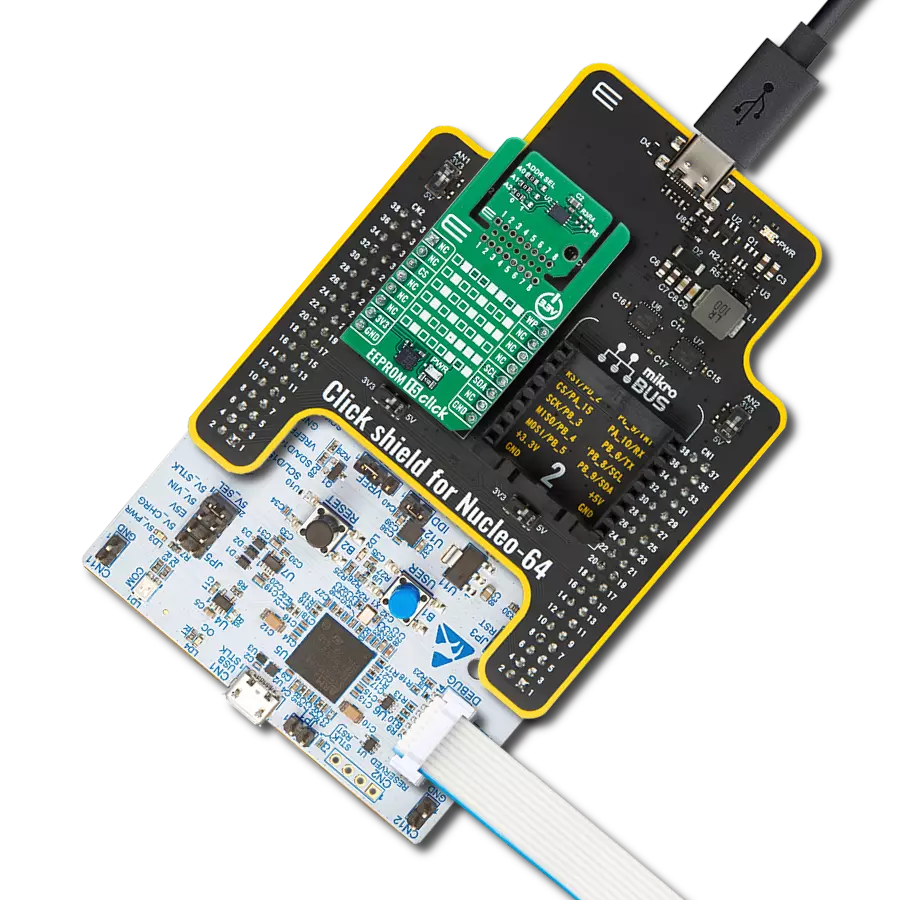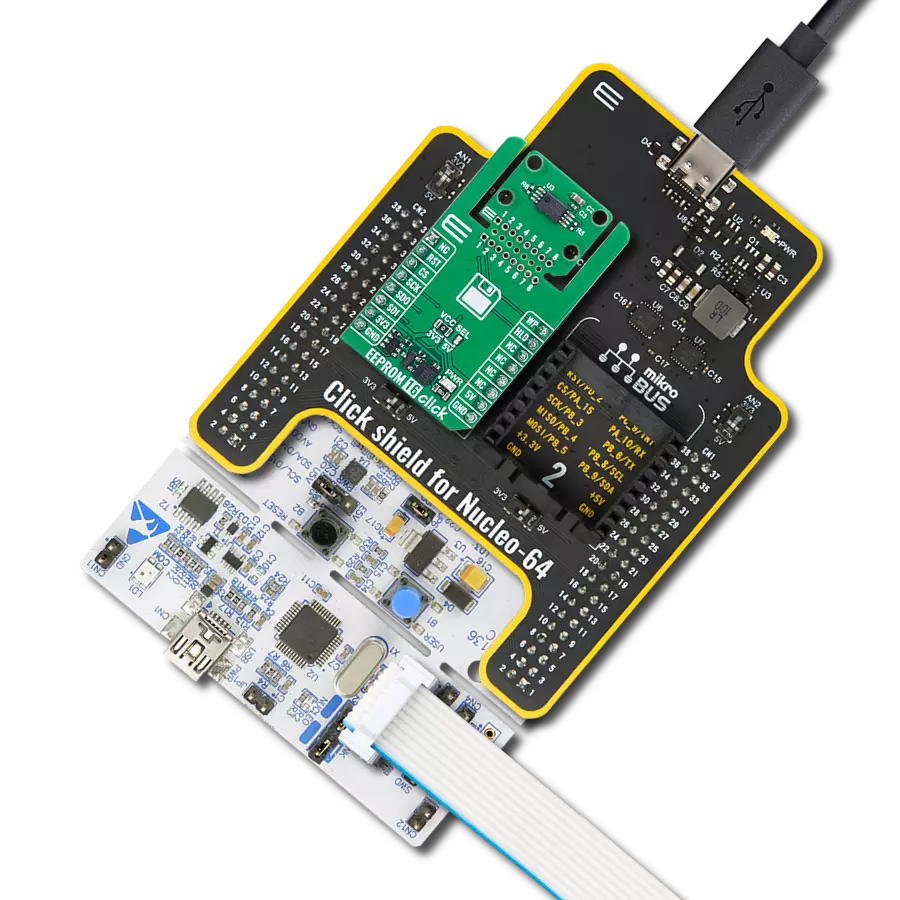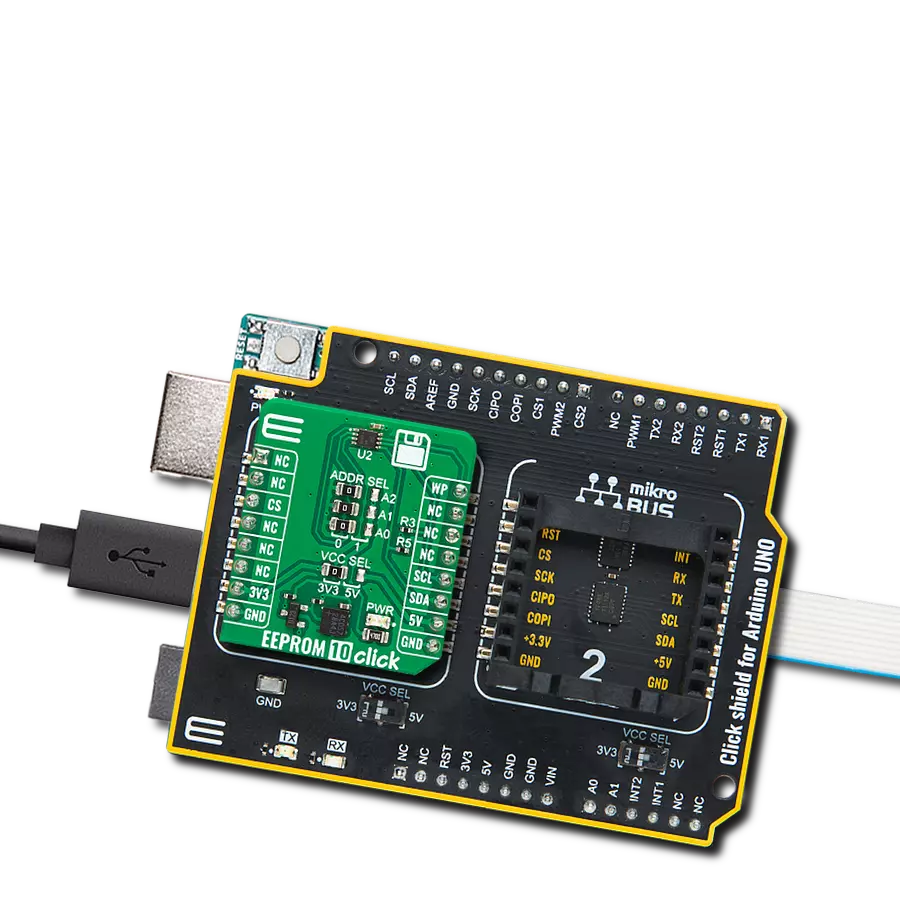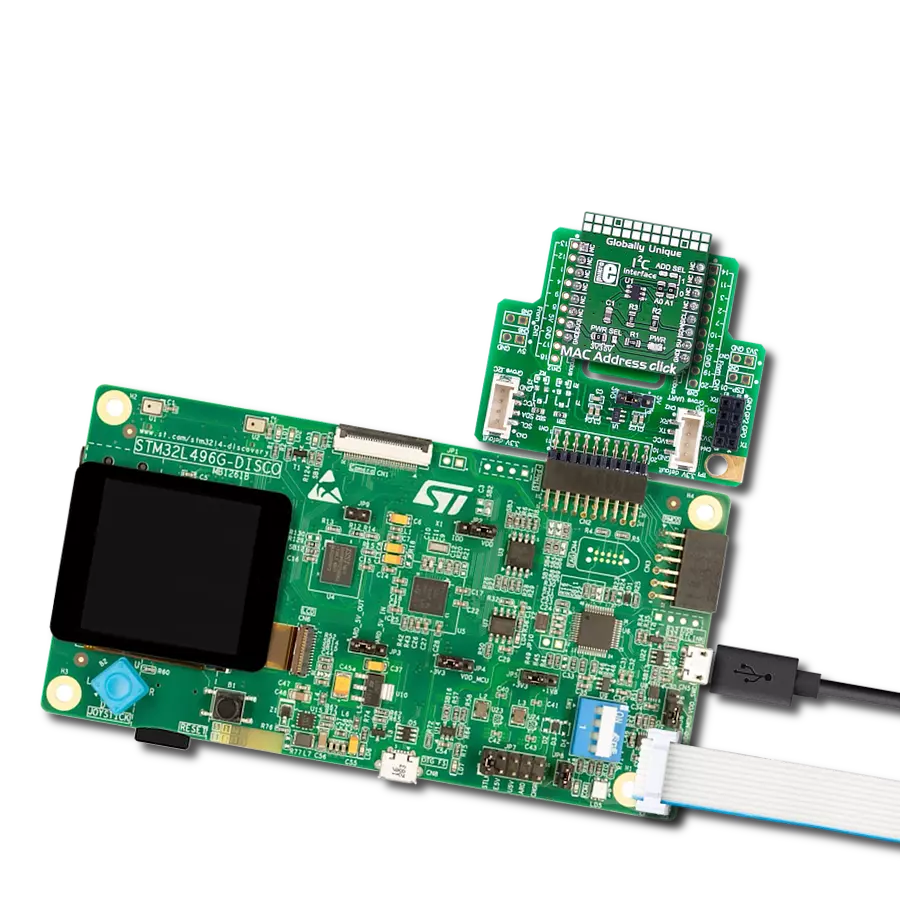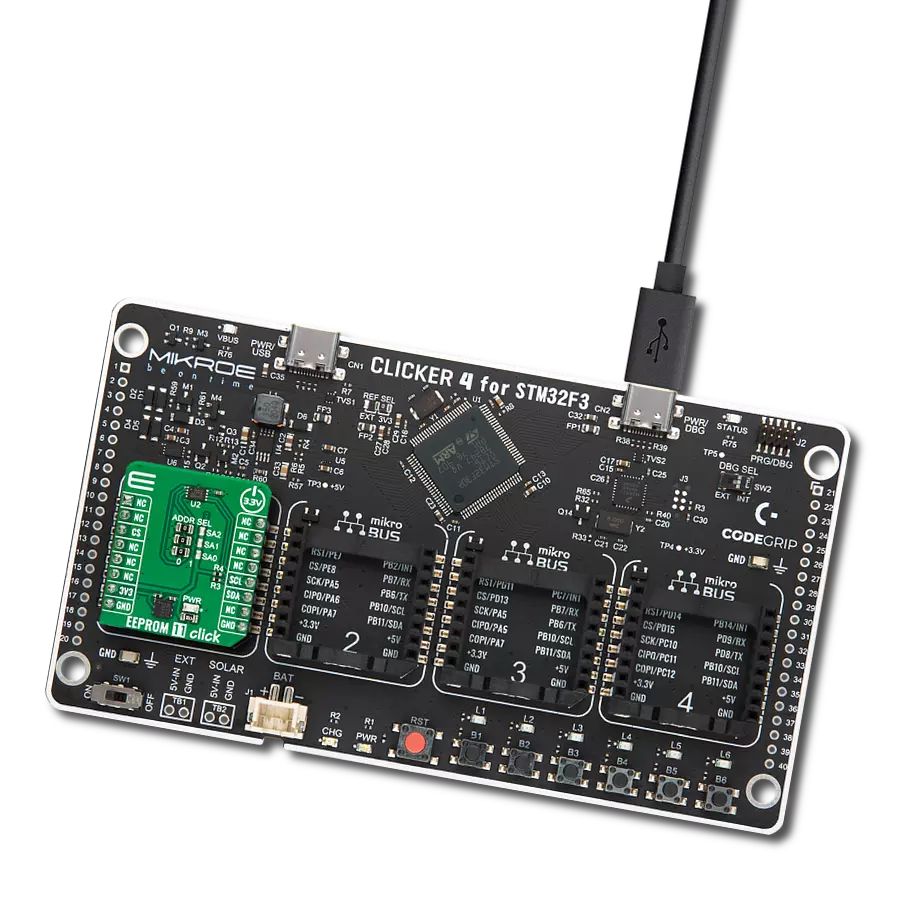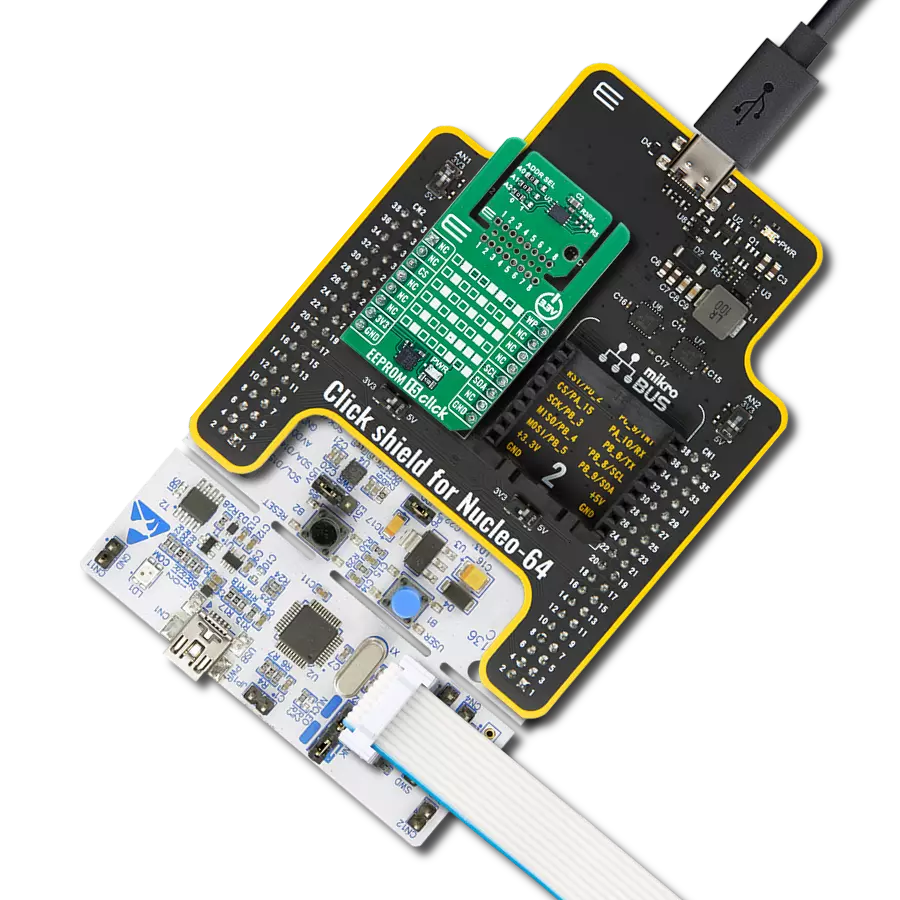A memory where important information can be written, erased, and read as needed, even when the device is turned off
A
A
Hardware Overview
How does it work?
EEPROM 12 Click is based on the M24256E, an EEPROM from STMicroelectronics. The protections include write protection of the whole memory array, enhanced ESD/latch-up protection, and more. It can withstand over 4 million write cycles and has over 200 years of data retention. It has a write time both for byte or page within 5ms and supports random and sequential read modes. The write page mode allows up to 64 bytes to be written in a single write cycle. The error correction code (ECC) is implemented on each group of four
EEPROM bytes, which improves the read reliability. During the internal write cycle, the device disconnects itself from the bus and writes a copy of the data from its internal latches to the memory cells. This, in turn, minimizes write delays. EEPROM 12 Click uses a standard 2-Wire interface to communicate with the host MCU, supporting a clock frequency of up to 1MHz. The EEPROM supports a configurable device address register (CDA), which allows the user to define the device address and a device address lock (DAL) to freeze
the configurable device address register. The EEPROM also supports a write control protection, which can be accessed over the WC pin. This Click board™ can operate with either 3.3V or 5V logic voltage levels selected via the VCC SEL jumper. This way, both 3.3V and 5V capable MCUs can use the communication lines properly. Also, this Click board™ comes equipped with a library containing easy-to-use functions and an example code that can be used as a reference for further development.
Features overview
Development board
Curiosity PIC32 MZ EF development board is a fully integrated 32-bit development platform featuring the high-performance PIC32MZ EF Series (PIC32MZ2048EFM) that has a 2MB Flash, 512KB RAM, integrated FPU, Crypto accelerator, and excellent connectivity options. It includes an integrated programmer and debugger, requiring no additional hardware. Users can expand
functionality through MIKROE mikroBUS™ Click™ adapter boards, add Ethernet connectivity with the Microchip PHY daughter board, add WiFi connectivity capability using the Microchip expansions boards, and add audio input and output capability with Microchip audio daughter boards. These boards are fully integrated into PIC32’s powerful software framework, MPLAB Harmony,
which provides a flexible and modular interface to application development a rich set of inter-operable software stacks (TCP-IP, USB), and easy-to-use features. The Curiosity PIC32 MZ EF development board offers expansion capabilities making it an excellent choice for a rapid prototyping board in Connectivity, IOT, and general-purpose applications.
Microcontroller Overview
MCU Card / MCU
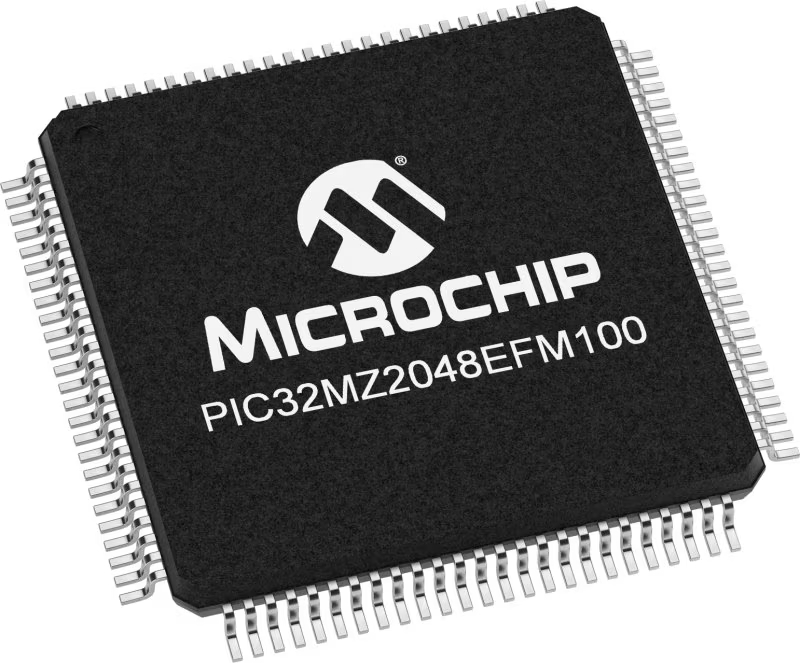
Architecture
PIC32
MCU Memory (KB)
2048
Silicon Vendor
Microchip
Pin count
100
RAM (Bytes)
524288
Used MCU Pins
mikroBUS™ mapper
Take a closer look
Click board™ Schematic
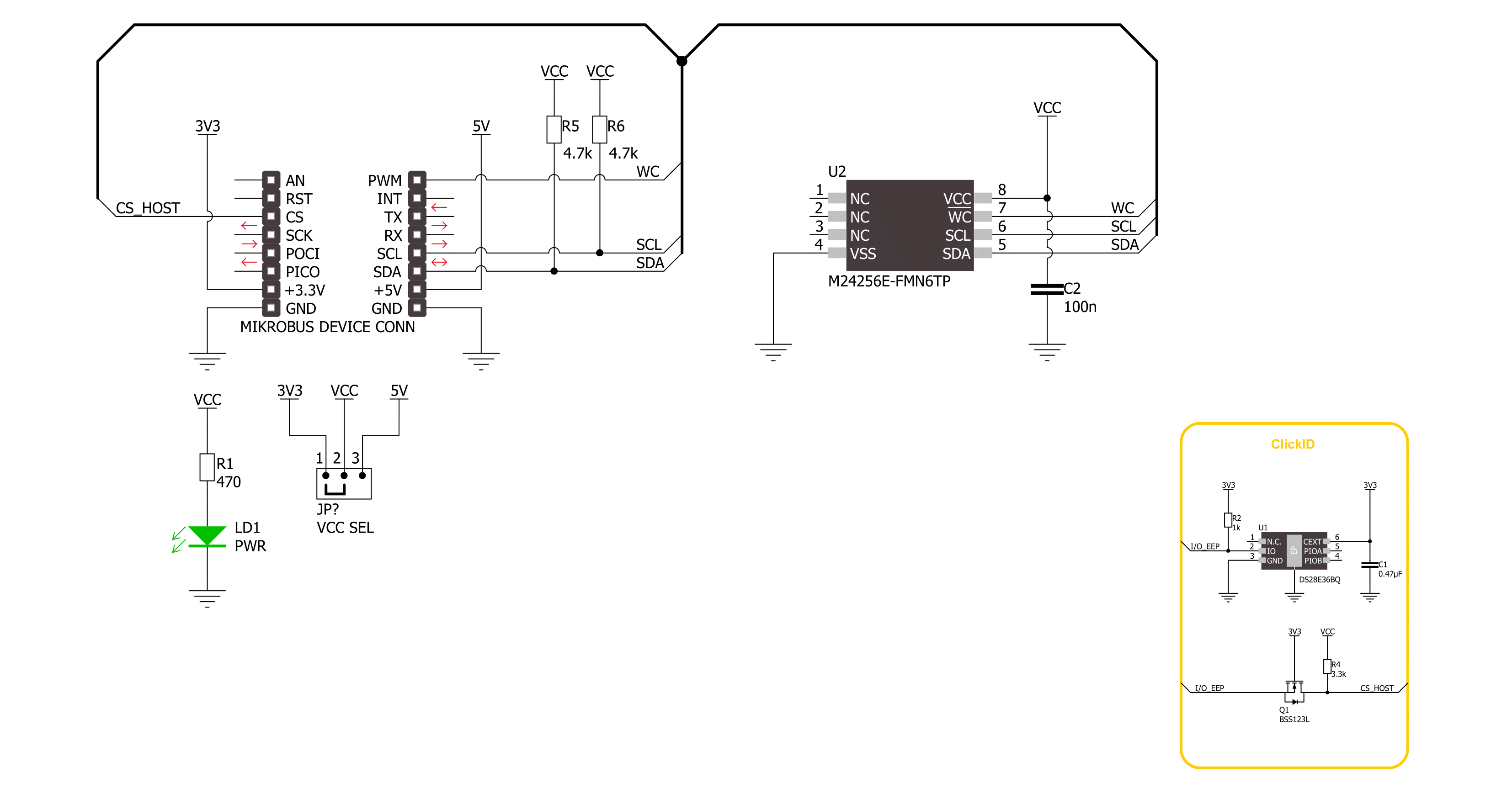
Step by step
Project assembly
Track your results in real time
Application Output
1. Application Output - In Debug mode, the 'Application Output' window enables real-time data monitoring, offering direct insight into execution results. Ensure proper data display by configuring the environment correctly using the provided tutorial.

2. UART Terminal - Use the UART Terminal to monitor data transmission via a USB to UART converter, allowing direct communication between the Click board™ and your development system. Configure the baud rate and other serial settings according to your project's requirements to ensure proper functionality. For step-by-step setup instructions, refer to the provided tutorial.

3. Plot Output - The Plot feature offers a powerful way to visualize real-time sensor data, enabling trend analysis, debugging, and comparison of multiple data points. To set it up correctly, follow the provided tutorial, which includes a step-by-step example of using the Plot feature to display Click board™ readings. To use the Plot feature in your code, use the function: plot(*insert_graph_name*, variable_name);. This is a general format, and it is up to the user to replace 'insert_graph_name' with the actual graph name and 'variable_name' with the parameter to be displayed.

Software Support
Library Description
This library contains API for EEPROM 12 Click driver.
Key functions:
eeprom12_memory_write- EEPROM 12 memory write function.eeprom12_memory_read- EEPROM 12 memory read function.
Open Source
Code example
The complete application code and a ready-to-use project are available through the NECTO Studio Package Manager for direct installation in the NECTO Studio. The application code can also be found on the MIKROE GitHub account.
/*!
* @file main.c
* @brief EEPROM 12 Click example
*
* # Description
* This example demonstrates the use of EEPROM 12 Click board™.
* The demo app writes specified data to the memory and reads it back.
*
* The demo application is composed of two sections :
*
* ## Application Init
* The initialization of I2C module, log UART, and additional pins.
*
* ## Application Task
* The demo application writes a desired number of bytes to the memory
* and then verifies if it is written correctly
* by reading from the same memory location and displaying the memory content.
* Results are being sent to the UART Terminal, where you can track their changes.
*
* @author Nenad Filipovic
*
*/
#include "board.h"
#include "log.h"
#include "eeprom12.h"
static eeprom12_t eeprom12;
static log_t logger;
#define DEMO_TEXT_MESSAGE_1 "MikroE"
#define DEMO_TEXT_MESSAGE_2 "EEPROM 12 Click"
#define STARTING_ADDRESS 0x4321
void application_init ( void )
{
log_cfg_t log_cfg; /**< Logger config object. */
eeprom12_cfg_t eeprom12_cfg; /**< Click config object. */
/**
* Logger initialization.
* Default baud rate: 115200
* Default log level: LOG_LEVEL_DEBUG
* @note If USB_UART_RX and USB_UART_TX
* are defined as HAL_PIN_NC, you will
* need to define them manually for log to work.
* See @b LOG_MAP_USB_UART macro definition for detailed explanation.
*/
LOG_MAP_USB_UART( log_cfg );
log_init( &logger, &log_cfg );
log_info( &logger, " Application Init " );
// Click initialization.
eeprom12_cfg_setup( &eeprom12_cfg );
EEPROM12_MAP_MIKROBUS( eeprom12_cfg, MIKROBUS_1 );
if ( I2C_MASTER_ERROR == eeprom12_init( &eeprom12, &eeprom12_cfg ) )
{
log_error( &logger, " Communication init." );
for ( ; ; );
}
Delay_ms ( 100 );
log_info( &logger, " Application Task " );
Delay_ms ( 100 );
}
void application_task ( void )
{
uint8_t data_buf[ 128 ] = { 0 };
memcpy( data_buf, DEMO_TEXT_MESSAGE_1, strlen( DEMO_TEXT_MESSAGE_1 ) );
if ( EEPROM12_OK == eeprom12_memory_write( &eeprom12, STARTING_ADDRESS,
data_buf,
strlen( DEMO_TEXT_MESSAGE_1 ) ) )
{
log_printf( &logger, " Write data: %s\r\n", data_buf );
Delay_ms ( 100 );
}
memset( data_buf, 0, sizeof( data_buf ) );
Delay_ms ( 100 );
if ( EEPROM12_OK == eeprom12_memory_read( &eeprom12, STARTING_ADDRESS,
data_buf,
strlen( DEMO_TEXT_MESSAGE_1 ) ) )
{
Delay_ms ( 100 );
log_printf( &logger, " Read data: %s\r\n\n", data_buf );
Delay_ms ( 1000 );
Delay_ms ( 1000 );
Delay_ms ( 1000 );
}
memcpy( data_buf, DEMO_TEXT_MESSAGE_2, strlen( DEMO_TEXT_MESSAGE_2 ) );
if ( EEPROM12_OK == eeprom12_memory_write( &eeprom12, STARTING_ADDRESS,
data_buf,
strlen( DEMO_TEXT_MESSAGE_2 ) ) )
{
log_printf( &logger, " Write data: %s\r\n", data_buf );
Delay_ms ( 100 );
}
memset( data_buf, 0, sizeof( data_buf ) );
Delay_ms ( 100 );
if ( EEPROM12_OK == eeprom12_memory_read( &eeprom12, STARTING_ADDRESS,
data_buf,
strlen( DEMO_TEXT_MESSAGE_2 ) ) )
{
Delay_ms ( 100 );
log_printf( &logger, " Read data: %s\r\n\n", data_buf );
Delay_ms ( 1000 );
Delay_ms ( 1000 );
Delay_ms ( 1000 );
}
}
int main ( void )
{
/* Do not remove this line or clock might not be set correctly. */
#ifdef PREINIT_SUPPORTED
preinit();
#endif
application_init( );
for ( ; ; )
{
application_task( );
}
return 0;
}
// ------------------------------------------------------------------------ END

















